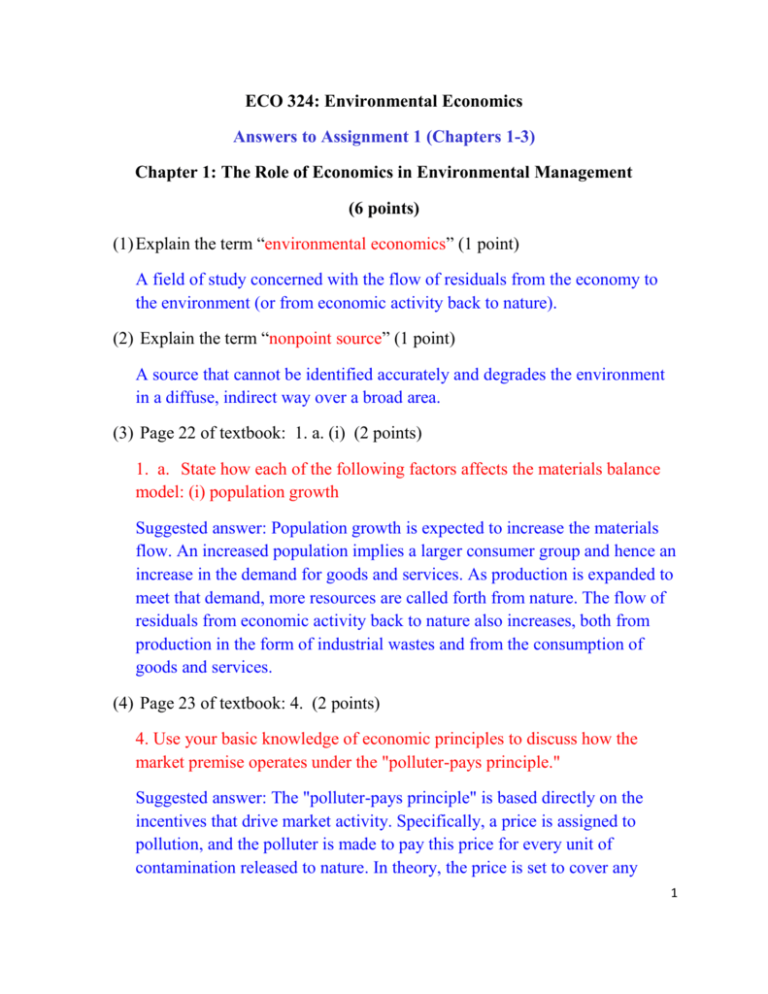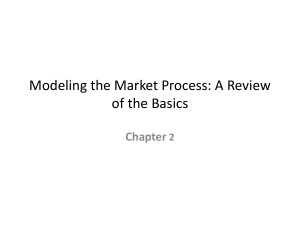Environmental Economics Assignment 1 Answers
advertisement

ECO 324: Environmental Economics Answers to Assignment 1 (Chapters 1-3) Chapter 1: The Role of Economics in Environmental Management (6 points) (1) Explain the term “environmental economics” (1 point) A field of study concerned with the flow of residuals from the economy to the environment (or from economic activity back to nature). (2) Explain the term “nonpoint source” (1 point) A source that cannot be identified accurately and degrades the environment in a diffuse, indirect way over a broad area. (3) Page 22 of textbook: 1. a. (i) (2 points) 1. a. State how each of the following factors affects the materials balance model: (i) population growth Suggested answer: Population growth is expected to increase the materials flow. An increased population implies a larger consumer group and hence an increase in the demand for goods and services. As production is expanded to meet that demand, more resources are called forth from nature. The flow of residuals from economic activity back to nature also increases, both from production in the form of industrial wastes and from the consumption of goods and services. (4) Page 23 of textbook: 4. (2 points) 4. Use your basic knowledge of economic principles to discuss how the market premise operates under the "polluter-pays principle." Suggested answer: The "polluter-pays principle" is based directly on the incentives that drive market activity. Specifically, a price is assigned to pollution, and the polluter is made to pay this price for every unit of contamination released to nature. In theory, the price is set to cover any 1 damages to health or the ecology associated with any contamination. Hence, the "full costs" of production are captured within the market transaction. Furthermore, since costs erode profits, the profit-maximizing producer has an incentive to reduce the amount of polluting residuals released. Chapter 2: Modeling the Market Process: A Review of the Basics (7 points) (1) Page 50 of textbook: 2. (1 point) In 1995, the Food and Drug Administration published new labeling standards for bottled water. (The full text of the final rule can be found at http://cfr.vlex.com/vid/165-110-bottled-water-19705533). Prior to that time, bottlers could sell regular tap water under a bottled water label. In fact, the FDA estimated that approximately 25 percent of the supply of bottled water was nothing more than ordinary tap water. Consider how these tougher standards eliminated 25 percent of the supply of bottled water. If market demand is unaffected, what qualitative impact would this labeling change have on equilibrium price and quantity for bottled water? Support your answer with a graphical model. Suggested answer: Given the reduction in the supply of bottled water, the equilibrium price should rise and the equilibrium quantity should decrease. [The graph should show a left shift of the market supply curve and the qualitative effect on equilibrium price and quantity.] 2 P S' S PE' PE D QE' QE Q (2) Page 50 of textbook: 3. (I simplified part c.) Reconsider the implications of the revised labeling standards discussed in Question 2 in the context of the hypothetical market for bottled water modeled in the text. Recall that the market demand and market supply equations are QD = –100P + 1150 and QS = 400P – 100, where PE = $2.50 and QE = 900. Now, suppose the change in standards results in a new market supply of QS'= 400P – 350, with no change in market demand. a. Determine the new PE' and QE' for bottled water. Do your results agree with your intuitive answer to Question 2 on page 50 of textbook? (2 points) Suggested answer: QD = QS' –100P + 1150 = 400P – 350 PE '= $3.00 and QE '= 850 3 So, PE ' (which is $3.00) > PE (which is $2.50), and QE ' (which is 850) < QE (which is 900). The equilibrium price rises and the equilibrium quantity decreases. Yes, the results agree with my intuitive answer to Question 2 on page 50 of textbook. b. Graphically illustrate the market for bottled water before and after the change in labeling standards. Be sure to label all relevant points. (2 points) P $11.50 A S’ $3.00 B $2.50 -350 $0.875 C $0.25 -100 E’ 850 900 S D Q 1150 4 c. (This part is different from part c in your textbook.) Only calculate consumer surplus and producer surplus after the change in labeling standards. (2 points) Suggested answer: CS = the area of AE’B = ½ x 850 x ($11.50 –$ 3.00) = $ 3,612.50 PS = the area of BE’C = ½ x 850 x ($3.00 - $0.875) = $ 903.125 Chapter 3: Modeling Market Failure (7 points) (1) Page 77 of textbook: 1. (1 point) Use economic analysis to evaluate the following statement: The only amount of acceptable pollution is no pollution at all. Suggested answer: We should recognize the flaw in assuming that the optimal level of pollution is zero. While this may be the case in certain instances, it is the exception rather than the rule. The general solution is that the optimal level of abatement occurs where the associated marginal social benefit is equal to the marginal social cost. This optimal level is not necessarily zero. From a general perspective, abating at the 100 percent level to reduce pollution to zero involves prohibitive opportunity costs. These include the forgone production and consumption of any good generating even the smallest amount of pollution. Given our present technology, a zero-pollution world would be one without electricity, advanced transportation systems, and virtually all manufactured products. It makes little sense to argue for the elimination of all pollution in our environment. (2) Page 77 of textbook: 3. (both a. and b.) 5 Assume that a small town uses a referendum to overcome the free-ridership problem and determine how its residents might value a new water filtration system for its public water supply. The voting results are aggregated by the town’s two districts, yielding the following demand estimates: District 1: Q = 160 – 20P1 District 2: Q = 60 – 5P2, where Q is the expected percent of copper to be filtered by the system and P is the price in millions of dollars. a. Based on these estimates, determine the town’s market demand for this public good, the new filtration system. (2 points) Suggested answer: Because this is a public good, the two demands must first be written in inverse form and then summed. The reasoning is that, for a public good, each demander is expressing a willingness to pay for the same quantity. The inverse demand equations are: P1 = 8 – 0.05Q P2 = 12 – 0.2Q Summing these yields the market demand, which is P = 20 – 0.25Q b. If the market supply for the system were P = 6 + 0.15Q, what would be the equilibrium price and quantity for the town? (2 points) Suggested answer: Equate the market demand and market supply and solve, as follows: 20 – 0.25Q = 0.4Q = QE = 6 + 0.15Q 14 35 percent Substitute QE into either equation to find PE as follows: 6 PE = 20 – 0.25(35) or 6 + 0.15(35) = $11.25 million (3) Page 77 of textbook: 5. (only a.) A New Hampshire textile mill releases pollution into nearby wetlands, and the associated health and ecological damages are not considered in the private market. Suppose you are an environmental economist working with the following marginal benefits and costs for this market, where Q is thousands of pounds and P is price per pound. MPB = 800 – 0.5Q MPC = 20 + 0.3Q MEB = 0 MEC = 0.4Q a. Find the competitive equilibrium, QC and PC, and the efficient equilibrium, QE and PE. (2 points) Suggested answer: Competitive equilibrium is found where: MPB = 800 – 0.5Q = 0.8Q = QC = MPC 20 + 0.3Q 780 975 thousand pounds PC = 800 – 0.5(975) or 20 + 0.3(975) = $312.50 Efficient equilibrium is found where: MSB = MSC MPB + MEB = MPC + MEC 800 – 0.5Q + 0 = 20 + 0.3Q + 0.4Q 1.2Q = 780 QE = 650 thousand pounds PE = 800 – 0.5(650) or 20 + 0.7(650) = $475 7







